Repellent Activity of Clove Essential Oil Volatiles and Development of Nanofiber-Based Dispensers against Pear Psyllids (Hemiptera: Psyllidae)
Abstract
:Simple Summary
Abstract
1. Introduction
2. Materials and Methods
2.1. Insects
2.2. Materials
2.2.1. Clove Oil Components
2.2.2. Preparation of Polymer Solution
2.3. Electrospinning
2.4. Olfactometer Assays
- (a)
- Three substances and mixtures (Table 1) were used to study the repellent effect of synthetic compounds contained in clove essential oil on female adults of C. pyri and C. pyricola. A stock solution of all mixtures (concentrations of each compound, Table 1) was prepared and then diluted with methanol to 5% final concentration. For each substance or mixture, 3 µL were applied onto a filter paper (2.5 × 2.5 cm) and kept for five minutes under a ventilated hood for solvent evaporation. The filter paper and the volatiles were presented in one arm of the olfactometer simultaneously with purified air in the other arm. The volatile samples were renewed on an hourly basis.
- (b)
- To observe the host odor masking effect of the M6 mixture of clove volatiles in the presence of pear tree volatiles, one potted pear plant cv. ‘Williams-Christ’ (50 cm) was carefully wrapped in oven plastic bags (Toppits, Melitta, Minden, Germany, 31 × 50 cm) and connected to one of the test arms. In the other arm an empty oven bag was used as control. Air was pumped to the wrapped plants and empty oven bag for 30 min before the experiment to stabilize the system. The airflow passing at the outlet of the oven bags and entering each olfactometer arm was controlled by a flowmeter (MASS-STREAM, M + W Instruments, Allershausen, Germany) and adjusted with plastic valves. In the olfactometer arm contained the pear volatiles, a filter paper containing the M6 mixture, as described above, was added, and the other arm was supplied only with solvent.
- (c)
- For the test with volatiles encapsulated into nanofibers, a 3 mg piece of nanofibers loaded with 5% of the volatile M6 mix was offered in one olfactometer arm. As a control, purified air was pumped into the other arm. The masking effect of the nanoformulation was also tested as above: in one olfactometer arm, nanofiber + M6 was offered with the pear volatiles, and the other arm was supplied only with air.
2.5. Field Trials
2.6. Release Rates Study
2.6.1. Micro-Chamber/Thermal Extractor Method
2.6.2. Thermodesorption—GC/MS
2.6.3. Identification and Quantification of Essential Oil Compounds with AMDIS
2.7. Statistical Analysis
3. Results
3.1. Olfactometer Assays
3.2. Field Trials
3.3. Release Rates
4. Discussion
Author Contributions
Funding
Institutional Review Board Statement
Informed Consent Statement
Data Availability Statement
Acknowledgments
Conflicts of Interest
References
- Seemüller, E.; Marcone, C.; Lauer, U.; Ragozzino, A.; Göschl, M. Current status of molecular classification of the phytoplasmas. J. Plant Pathol. 1998, 80, 3–26. [Google Scholar]
- Seemüller, E.; Schneider, B. ‘Candidatus Phytoplasma mali’, ‘Candidatus Phytoplasma pyri’ and ‘Candidatus Phytoplasma prunorum’, the causal agents of apple proliferation, pear decline and European stone fruit yellows, respectively. Int. J. Syst. Evol. Microbiol. 2004, 54, 1217–1226. [Google Scholar] [CrossRef] [PubMed]
- Jarausch, B.; Tedeschi, R.; Sauvion, N.; Gross, J.; Jarausch, W. Psyllid vectors. In Phytoplasmas: Plant Pathogenic Bacteria-II: Transmission and Management of Phytoplasma-Associated Diseases; Bertaccini, A., Weintraub, P.G., Rao, G.P., Mori, N., Eds.; Springer: Singapore, 2019; pp. 53–78. [Google Scholar]
- Osler, R.; Loi, N.; Ermacora, P.; Refatti, E.; Carraro, L. (Eds.) Fruit tree phytoplasma diseases diffused in nature by psyllids. In Proceedings of the XVIII International Symposium on Virus and Virus-like Diseases of Temperate Fruit Crops-Top Fruit Diseases 550, Canterbury, UK, 9–15 July 2000. [Google Scholar] [CrossRef]
- Garcia-Chapa, M.; Sabaté, J.; Laviña, A.; Batlle, A. Role of Cacopsylla pyri in the epidemiology of pear decline in Spain. Eur. J. Plant Pathol. 2005, 111, 9–17. [Google Scholar] [CrossRef]
- Carraro, L.; Osler, R.; Loi, N.; Ermacora, P.; Refatti, E. Transmission of European stone fruit yellows phytoplasma by Cacopsylla pruni. J. Plant Pathol. 1998, 80, 233–239. [Google Scholar]
- Lemoine, J. Is Psylla pyri a vector of pear decline in France? Bull. SROP 1984, 7, 245–251. [Google Scholar]
- Futuyma, D.J.; Agrawal, A.A. Macroevolution and the biological diversity of plants and herbivores. Proc. Natl. Acad. Sci. USA 2009, 106, 18054–18061. [Google Scholar] [CrossRef] [PubMed]
- Renwick, J. Host-Plant Selection by Phytophagous Insects; Bernays, E.A., Chapman, R.F., Eds.; Chapman & Hall, Inc.: New York, NY, USA, 1994; p. 312. [Google Scholar]
- Czarnobai De Jorge, B.; Rainer, M.; Andreas, J.; Gross, J. Preference of pear psylla (Cacopsylla pyri) for specific leaf color inspires new application in plant protection. Pest Manag. Sci. 2022; submitted. [Google Scholar]
- Horton, D.R.; Krysan, J.L. Host acceptance behavior of pear psylla (Homoptera: Psyllidae) affected by plant species, host deprivation, habituation, and eggload. Ann. Entomol. Soc. Am. 1991, 84, 612–627. [Google Scholar] [CrossRef]
- Soroker, V.; Talebaev, S.; Harari, A.R.; Wesley, S.D. The role of chemical cues in host and mate location in the pear psylla Cacopsylla bidens (Homoptera: Psyllidae). J. Insect Behav. 2004, 17, 613–626. [Google Scholar] [CrossRef]
- Deletre, E.; Schatz, B.; Bourguet, D.; Chandre, F.; Williams, L.; Ratnadass, A.; Martin, T. Prospects for repellent in pest control: Current developments and future challenges. Chemoecology 2016, 26, 127–142. [Google Scholar] [CrossRef]
- Mann, R.S.; Tiwari, S.; Smoot, J.M.; Rouseff, R.L.; Stelinski, L.L. Repellency and toxicity of plant-based essential oils and their constituents against Diaphorina citri Kuwayama (Hemiptera: Psyllidae). J. Appl. Entomol. 2012, 136, 87–96. [Google Scholar] [CrossRef]
- Stratton, C.A.; Hodgdon, E.; Rodriguez-Saona, C.; Shelton, A.M.; Chen, Y.H. Odors from phylogenetically-distant plants to Brassicaceae repel an herbivorous Brassica specialist. Sci. Rep. 2019, 9, 10621. [Google Scholar] [CrossRef] [PubMed]
- Regnault-Roger, C. The potential of botanical essential oils for insect pest control. Integr. Pest Manag. Rev. 1997, 2, 25–34. [Google Scholar] [CrossRef]
- Walling, L.L. The myriad plant responses to herbivores. J. Plant Growth Regul. 2000, 19, 195–216. [Google Scholar] [CrossRef] [PubMed]
- Bakkali, F.; Averbeck, S.; Averbeck, D.; Idaomar, M. Biological effects of essential oils—A review. Food Chem. Toxicol. 2008, 46, 446–475. [Google Scholar] [CrossRef] [PubMed]
- Sosa, M.E.; Tonn, C.E. Plant secondary metabolites from Argentinean semiarid lands: Bioactivity against insects. Phytochem. Rev. 2008, 7, 3–24. [Google Scholar] [CrossRef]
- Isman, M.B. Botanical insecticides, deterrents, and repellents in modern agriculture and an increasingly regulated world. Annu. Rev. Entomol. 2006, 51, 45–66. [Google Scholar] [CrossRef]
- Nerio, L.S.; Olivero-Verbel, J.; Stashenko, E. Repellent activity of essential oils: A review. Bioresour. Technol. 2010, 101, 372–378. [Google Scholar] [CrossRef]
- Egigu, M.C.; Ibrahim, M.A.; Yahya, A.; Holopainen, J.K. Yeheb (Cordeauxia edulis) extract deters feeding and oviposition of Plutella xylostella and attracts its natural enemy. BioControl 2010, 55, 613–624. [Google Scholar] [CrossRef]
- Weintraub, P.; Gross, J. Capturing insect vectors of phytoplasmas. In Phytoplasma; Springer: Totowa, NJ, USA, 2013; pp. 61–72. [Google Scholar]
- Chaieb, K.; Hajlaoui, H.; Zmantar, T.; Kahla-Nakbi, A.B.; Rouabhia, M.; Mahdouani, K.; Bakhrouf, A. The chemical composition and biological activity of clove essential oil, Eugenia caryophyllata (Syzigium aromaticum L. Myrtaceae): A short review. Phytother. Res. 2007, 21, 501–506. [Google Scholar] [CrossRef]
- Kafle, L.; Shih, C.J. Toxicity and repellency of compounds from clove (Syzygium aromaticum) to red imported fire ants Solenopsis invicta (Hymenoptera: Formicidae). J. Econ. Entomol. 2013, 106, 131–135. [Google Scholar] [CrossRef]
- Cortés-Rojas, D.F.; de Souza, C.R.F.; Oliveira, W.P. Clove (Syzygium aromaticum): A precious spice. Asian Pac. J. Trop. Biomed. 2014, 4, 90–96. [Google Scholar] [CrossRef]
- Appel, A.G.; Gehret, M.J.; Tanley, M.J. Repellency and toxicity of mint oil granules to red imported fire ants (Hymenoptera: Formicidae). J. Econ. Entomol. 2004, 97, 575–580. [Google Scholar] [CrossRef] [PubMed]
- UshaRani, P. Systemic toxicity of different plant derived chemicals and essential oils against safflower aphid, Uroleucon carthami (Homoptera: Aphididae). Indian J. Entomol. 2005, 66, 345–348. [Google Scholar]
- Kareem, T.A. Bioactive of five aromatic plant oils against aphids oleander Aphis nerii (Aphidae: Homoptera). Diyala Agric. Sci. J. 2012, 4, 177–186. [Google Scholar]
- Ho, S.; Cheng, L.; Sim, K.; Tan, H. Potential of cloves (Syzygium aromaticum (L.) Merr. and Perry as a grain protectant against Tribolium castaneum (Herbst) and Sitophilus zeamais Motsch. Postharvest Biol. Technol. 1994, 4, 179–183. [Google Scholar] [CrossRef]
- Kerdchoechuen, O.; Laohakunjit, N.; Singkornard, S.; Matta, F.B. Essential oils from six herbal plants for biocontrol of the maize weevil. HortScience 2010, 45, 592–598. [Google Scholar] [CrossRef]
- Mbonu, A. The potential for controlling Maruca vitrata Fab. and Clavigralla tomentosicollis Stal. using different concentrations and spraying schedules of Syzigium aromaticum (L.) Merr and Perr on cowpea plants. J. Plant Sci. 2010, 5, 172–177. [Google Scholar]
- Ajanta, B.; Sharma, T.; Shrawan, S.; Srivastava, R. Effect of aqueous leaf extract of cloves (Syzygium aromaticum) on growth and development of tobacco caterpillar (Spodoptera litura). Indian J. Agric. Sci. 2010, 80, 534–537. [Google Scholar]
- Tian, B.-L.; Liu, Q.-Z.; Liu, Z.-L.; Li, P.; Wang, J.-W. Insecticidal potential of clove essential oil and its constituents on Cacopsylla chinensis (Hemiptera: Psyllidae) in laboratory and field. J. Econ. Entomol. 2015, 108, 957–961. [Google Scholar] [CrossRef]
- Fu, Y.; Zu, Y.; Chen, L.; Shi, X.; Wang, Z.; Sun, S.; Efferth, T. Antimicrobial activity of clove and rosemary essential oils alone and in combination. Phytother. Res. 2007, 21, 989–994. [Google Scholar] [CrossRef]
- Srivastava, A.; Srivastava, S.; Syamsundar, K. Bud and leaf essential oil composition of Syzygium aromaticum from India and Madagascar. Flavour Fragr. J. 2005, 20, 51–53. [Google Scholar] [CrossRef]
- Samarasekera, R.; Weerasinghe, I.S.; Hemalal, K.P. Insecticidal activity of menthol derivatives against mosquitoes. Pest Manag. Sci. Former. Pestic. Sci. 2008, 64, 290–295. [Google Scholar] [CrossRef] [PubMed]
- Czarnobai De Jorge, B.; Gross, J. Chapter 13-Smart nanotextiles for application in sustainable agriculture. In Nanosensors and Nanodevices for Smart Multifunctional Textiles; Ehrmann, A., Nguyen, T.A., Nguyen Tri, P., Eds.; Elsevier: Amsterdam, The Netherlands, 2021; pp. 203–227. [Google Scholar] [CrossRef]
- Czarnobai De Jorge, B.; Bisotto-de-Oliveira, R.; Pereira, C.N.; Sant’Ana, J. Novel nanoscale pheromone dispenser for more accurate evaluation of Grapholita molesta (Lepidoptera: Tortricidae) attract-and-kill strategies in the laboratory. Pest Manag. Sci. 2017, 73, 1921–1926. [Google Scholar] [CrossRef] [PubMed]
- Burckhardt, D.; Hodkinson, I. A revision of the west Palaearctic pear psyllids (Hemiptera: Psyllidae). Bull. Entomol. Res. 1986, 76, 119–132. [Google Scholar] [CrossRef]
- Ossiannilsson, F. The Psylloidea (Homoptera) of Fennoscandia and Denmark; Brill: Leiden, The Netherlands, 1992. [Google Scholar]
- Görg, L.M.; Gallinger, J.; Gross, J. The phytopathogen ‘Candidatus Phytoplasma mali’ alters apple tree phloem composition and affects oviposition behavior of its vector Cacopsylla picta. Chemoecology 2021, 31, 31–45. [Google Scholar] [CrossRef]
- Gallinger, J.; Jarausch, B.; Jarausch, W.; Gross, J. Host plant preferences and detection of host plant volatiles of the migrating psyllid species Cacopsylla pruni, the vector of European Stone Fruit Yellows. J. Pest Sci. 2020, 93, 461–475. [Google Scholar] [CrossRef]
- Kuhns, E.H.; Martini, X.; Hoyte, A.; Stelinski, L.L. Repellent activity of botanical oils against Asian citrus psyllid, Diaphorina citri (hemiptera: Liviidae). Insects 2016, 7, 35. [Google Scholar] [CrossRef]
- Gross, J.; Gallinger, J.; Rid, M. Collection, identification, and statistical analysis of volatile organic compound patterns emitted by Phytoplasma infected plants. In Phytoplasmas; Springer: New York, NY, USA, 2019; pp. 333–343. [Google Scholar] [CrossRef]
- Lenth, R.; Singmann, H.; Love, J.; Buerkner, P.; Herve, M. Emmeans: Package ‘Emmeans’ Estimated Marginal Means. 2019. Available online: https://CRAN.R-project.org/package=emmeans (accessed on 20 May 2021).
- Prashar, A.; Locke, I.C.; Evans, C.S. Cytotoxicity of clove (Syzygium aromaticum) oil and its major components to human skin cells. Cell Prolif. 2006, 39, 241–248. [Google Scholar] [CrossRef]
- Hummelbrunner, L.A.; Isman, M.B. Acute, sublethal, antifeedant, and synergistic effects of monoterpenoid essential oil compounds on the tobacco cutworm, Spodoptera litura (Lep., Noctuidae). J. Agric. Food Chem. 2001, 49, 715–720. [Google Scholar] [CrossRef]
- Gillij, Y.; Gleiser, R.; Zygadlo, J. Mosquito repellent activity of essential oils of aromatic plants growing in Argentina. Bioresour. Technol. 2008, 99, 2507–2515. [Google Scholar] [CrossRef]
- Omolo, M.O.; Okinyo, D.; Ndiege, I.O.; Lwande, W.; Hassanali, A. Repellency of essential oils of some Kenyan plants against Anopheles gambiae. Phytochemistry 2004, 65, 2797–2802. [Google Scholar] [CrossRef] [PubMed]
- Levin, S.A. The problem of pattern and scale in ecology: The Robert H. MacArthur award lecture. Ecology 1992, 73, 1943–1967. [Google Scholar] [CrossRef]
- Randlkofer, B.; Obermaier, E.; Meiners, T. Mother’s choice of the oviposition site: Balancing risk of egg parasitism and need of food supply for the progeny with an infochemical shelter? Chemoecology 2007, 17, 177–186. [Google Scholar] [CrossRef]
- Patt, J.M.; Meikle, W.G.; Mafra-Neto, A.; Sétamou, M.; Mangan, R.; Yang, C.; Malik, N.; Adamczyk, J.J. Multimodal cues drive host-plant assessment in Asian citrus psyllid (Diaphorina citri). Environ. Entomol. 2011, 40, 1494–1502. [Google Scholar] [CrossRef] [PubMed]
- Wenninger, E.J.; Stelinski, L.L.; Hall, D.G. Roles of olfactory cues, visual cues, and mating status in orientation of Diaphorina citri Kuwayama (Hemiptera: Psyllidae) to four different host plants. Environ. Entomol. 2009, 38, 225–234. [Google Scholar] [CrossRef] [PubMed]
- Hodkinson, I. The biology of the Psylloidea (Homoptera): A review. Bull. Entomol. Res. 1974, 64, 325–338. [Google Scholar] [CrossRef]
- Alquézar, B.; Volpe, H.X.L.; Magnani, R.F.; de Miranda, M.P.; Santos, M.A.; Wulff, N.A.; Bento, J.M.; Parra, J.R.; Bouwmeester, H.; Peña, L. β-caryophyllene emitted from a transgenic Arabidopsis or chemical dispenser repels Diaphorina citri, vector of Candidatus Liberibacters. Sci. Rep. 2017, 7, 5639. [Google Scholar] [CrossRef] [PubMed]
- Alquézar, B.; Volpe, H.X.L.; Magnani, R.F.; de Miranda, M.P.; Santos, M.A.; Marques, V.V.; de Almeida, M.R.; Wulff, N.A.; Ting, H.M.; de Vries, M.; et al. Engineered orange ectopically expressing the arabidopsis β-caryophyllene synthase is not attractive to Diaphorina citri, the vector of the bacterial pathogen associated to huanglongbing. Front. Plant Sci. 2021, 12, 200. [Google Scholar] [CrossRef]
- Dash, T.K.; Konkimalla, V.B. Poly-ε-caprolactone based formulations for drug delivery and tissue engineering: A review. J. Control. Release 2012, 158, 15–33. [Google Scholar] [CrossRef]
- Zhang, L.; Xiong, C.; Deng, X. Biodegradable polyester blends for biomedical application. J. Appl. Polym. Sci. 1995, 56, 103–112. [Google Scholar] [CrossRef]
- Yu, L.; Petinakis, S.; Dean, K.; Bilyk, A.; Wu, D. Green polymeric blends and composites from renewable resources. Macromol. Symp. 2007, 249, 535–539. [Google Scholar] [CrossRef]
- Van der Schueren, L.; De Schoenmaker, B.; Kalaoglu, Ö.I.; De Clerck, K. An alternative solvent system for the steady state electrospinning of polycaprolactone. Eur. Polym. J. 2011, 47, 1256–1263. [Google Scholar] [CrossRef]
- Kanani, A.G.; Bahrami, S.H. Effect of changing solvents on poly (ε-caprolactone) nanofibrous webs morphology. J. Nanomater. 2011, 2011. [Google Scholar] [CrossRef]

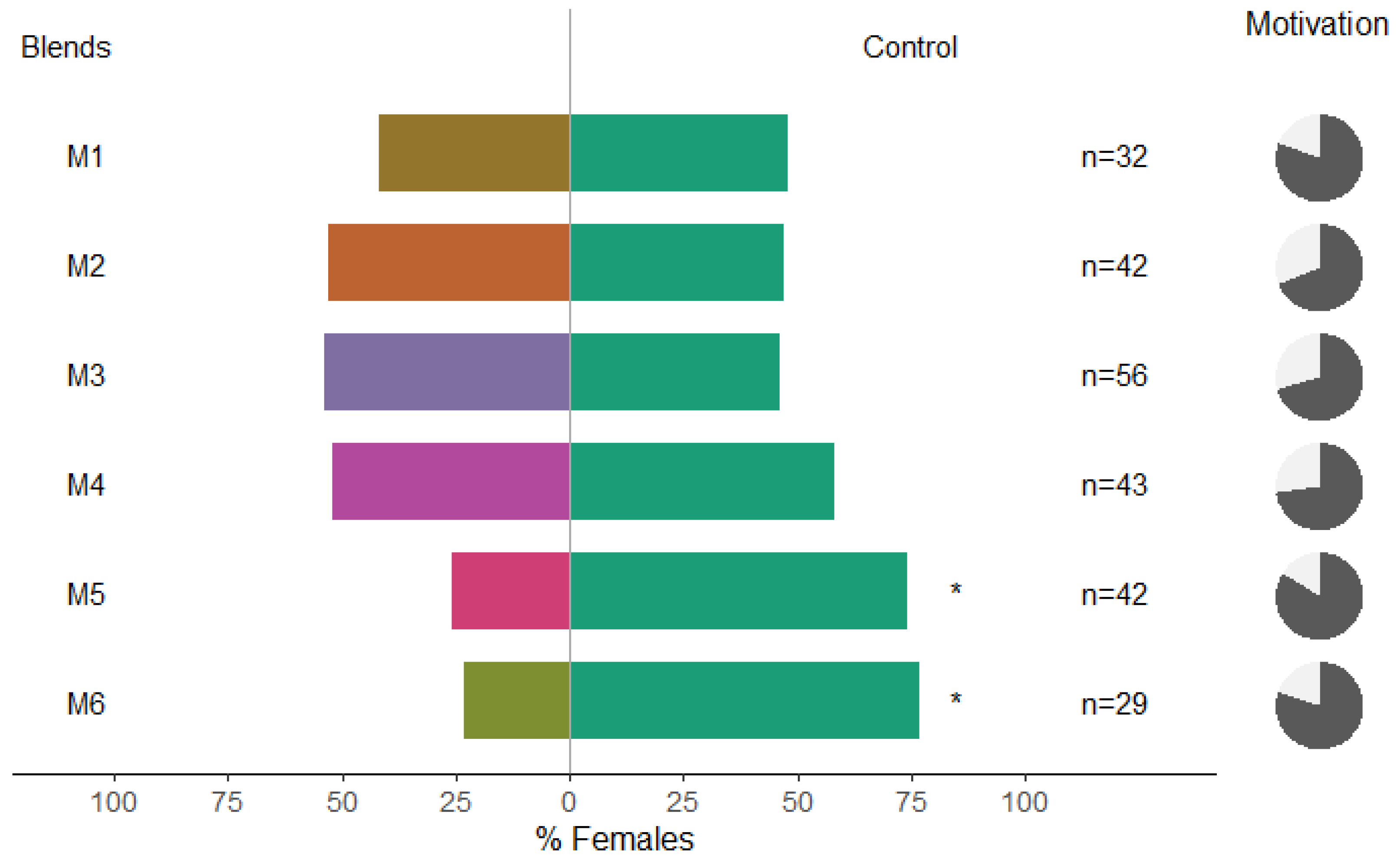

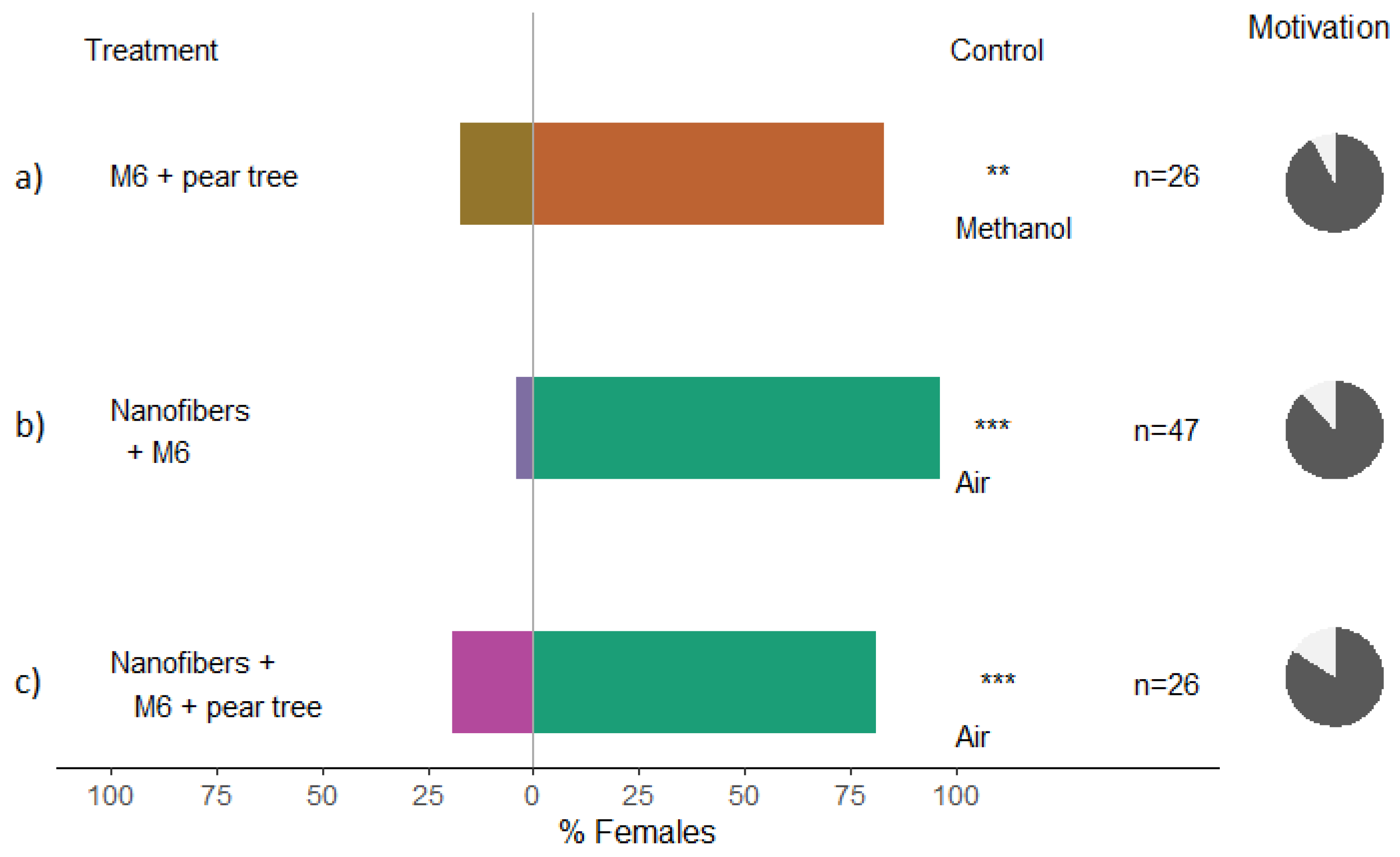
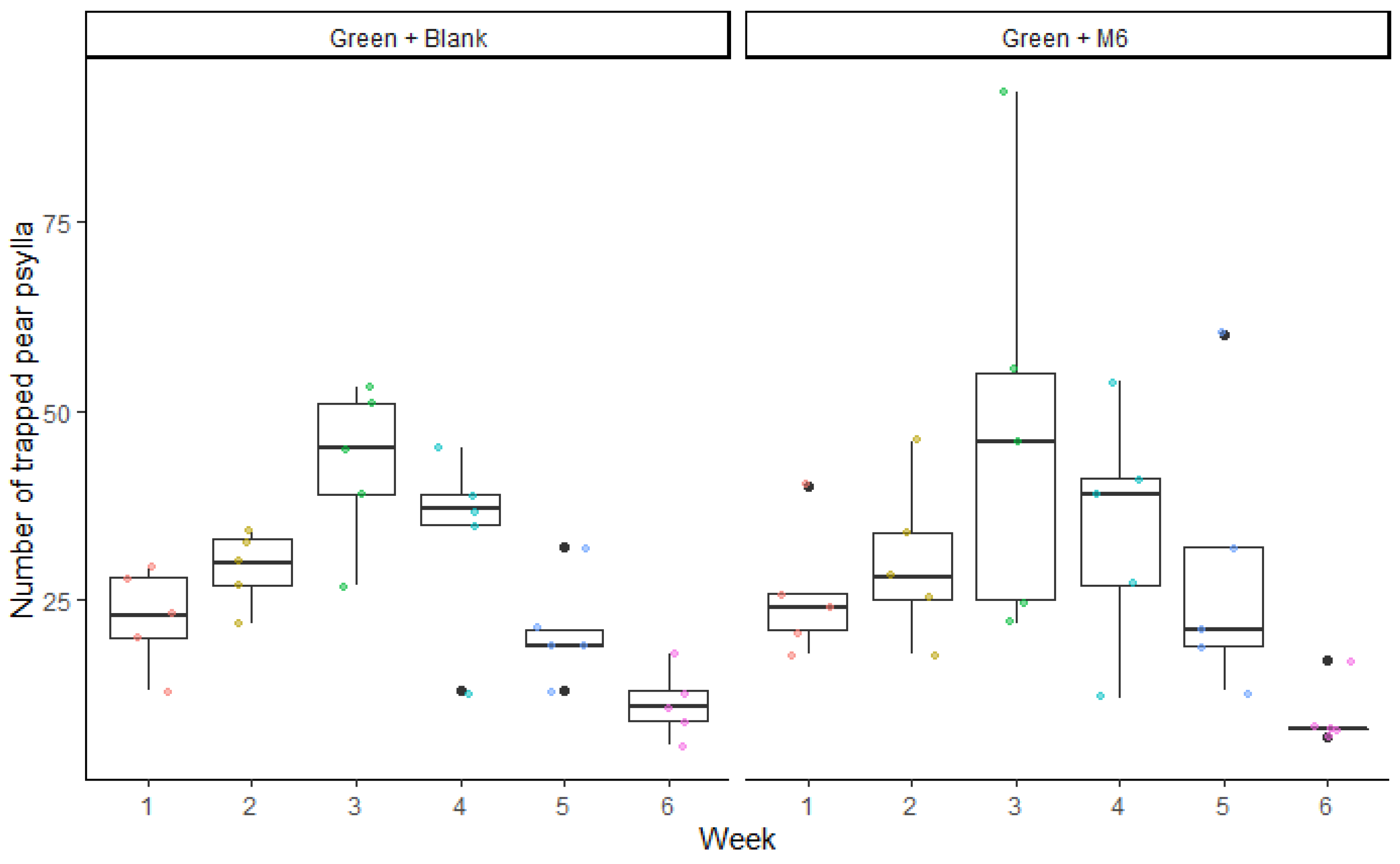
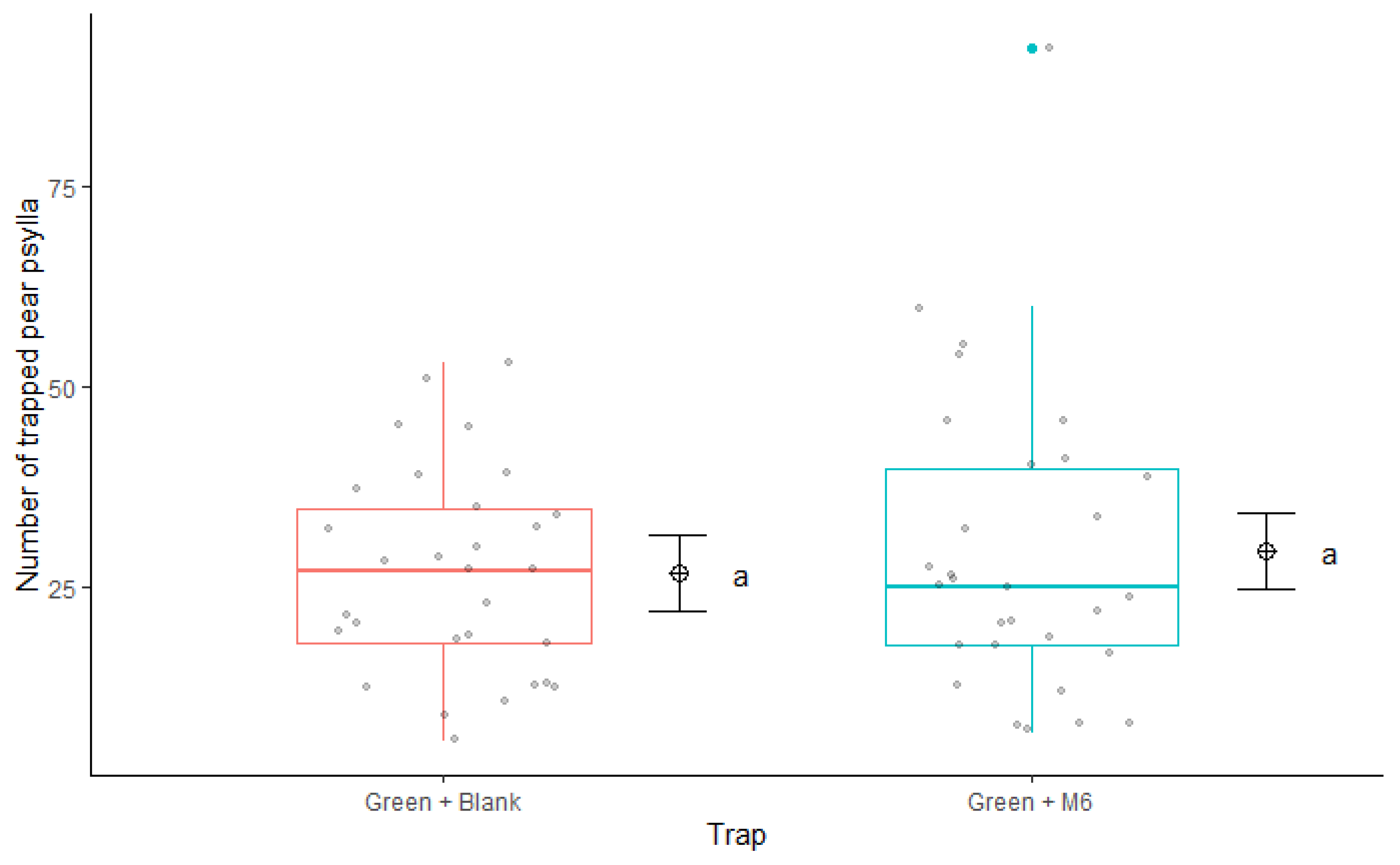
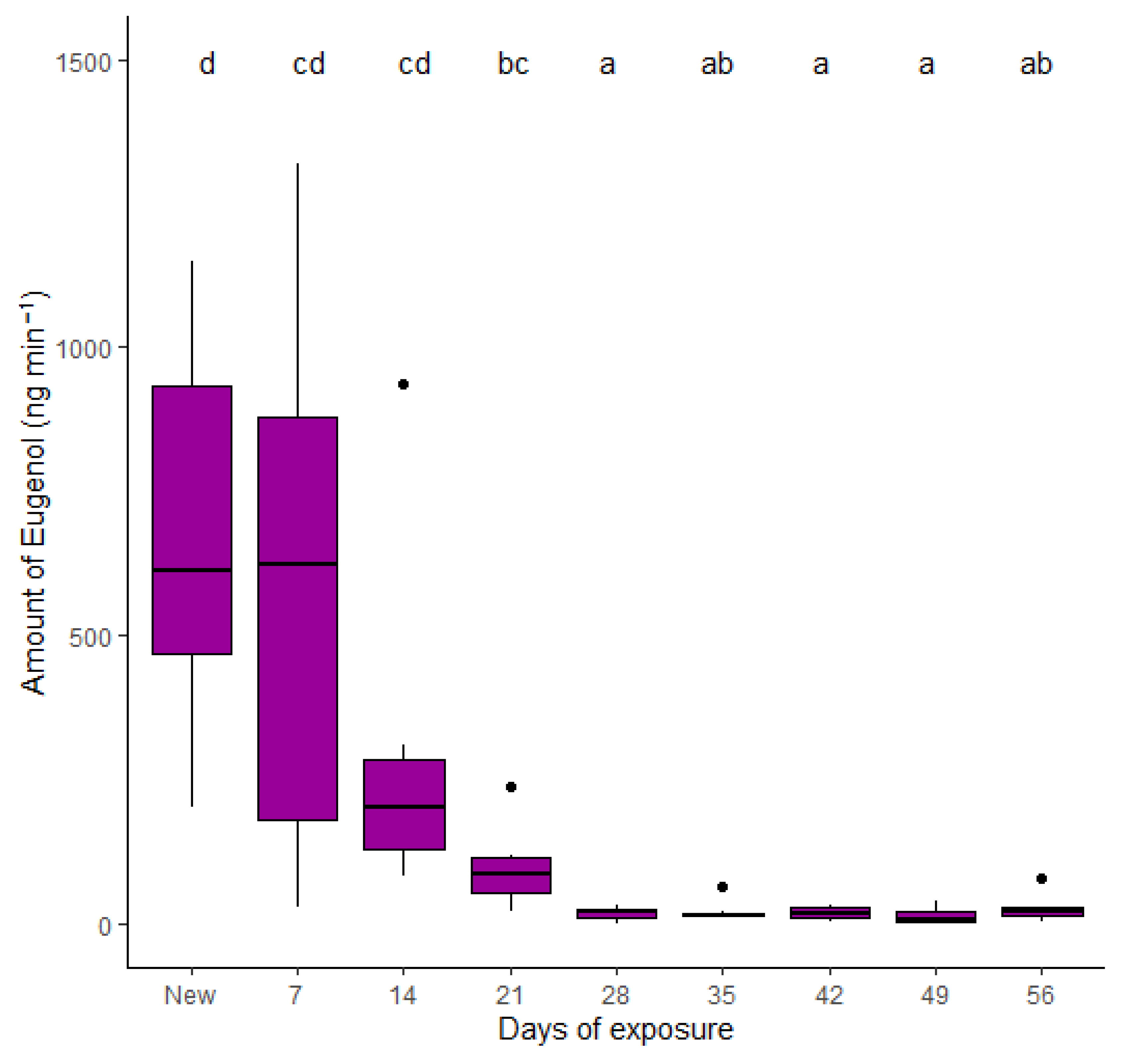
| Compounds | Amount (%) | M1 | M2 | M3 | M4 | M5 | M6 |
|---|---|---|---|---|---|---|---|
| Eugenol | 88.6 | + | + | + | + | ||
| Eugenyl acetate | 8.9 | + | + | + | |||
| β-Caryophyllene | 1.9 | + | + | + |
Publisher’s Note: MDPI stays neutral with regard to jurisdictional claims in published maps and institutional affiliations. |
© 2022 by the authors. Licensee MDPI, Basel, Switzerland. This article is an open access article distributed under the terms and conditions of the Creative Commons Attribution (CC BY) license (https://creativecommons.org/licenses/by/4.0/).
Share and Cite
Czarnobai De Jorge, B.; Hummel, H.E.; Gross, J. Repellent Activity of Clove Essential Oil Volatiles and Development of Nanofiber-Based Dispensers against Pear Psyllids (Hemiptera: Psyllidae). Insects 2022, 13, 743. https://doi.org/10.3390/insects13080743
Czarnobai De Jorge B, Hummel HE, Gross J. Repellent Activity of Clove Essential Oil Volatiles and Development of Nanofiber-Based Dispensers against Pear Psyllids (Hemiptera: Psyllidae). Insects. 2022; 13(8):743. https://doi.org/10.3390/insects13080743
Chicago/Turabian StyleCzarnobai De Jorge, Bruna, Hans E. Hummel, and Jürgen Gross. 2022. "Repellent Activity of Clove Essential Oil Volatiles and Development of Nanofiber-Based Dispensers against Pear Psyllids (Hemiptera: Psyllidae)" Insects 13, no. 8: 743. https://doi.org/10.3390/insects13080743
APA StyleCzarnobai De Jorge, B., Hummel, H. E., & Gross, J. (2022). Repellent Activity of Clove Essential Oil Volatiles and Development of Nanofiber-Based Dispensers against Pear Psyllids (Hemiptera: Psyllidae). Insects, 13(8), 743. https://doi.org/10.3390/insects13080743







